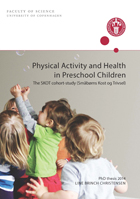PhD defence: Physical activity and health in preschool children
The SKOT cohort study
Line Brinch Christensen
PhD thesis
It is well established, that physical activity has protective effects regarding several lifestyle diseases for adults and older children. Research in younger children has been hindered by lack of methodological consensus. This makes it difficult to compare results across studies and to reach definitive conclusions. Accordingly, there is a lack of knowledge regarding how active preschool children are.
In this cohort of healthy Danish 3-year olds, the SKOT cohort, the children were more active on days when they attended day care, than on days when they did not attend daycare. There were large differences in activity among the least active and the most active quartile of children. Thus, some children appeared to be able to remain very active regardless of time and setting, while the least active children remained constantly low-active regardless of time and setting.
Time spent in light, moderate and high intensity activity, as well as time spent sedentary was independently associated with a number of essential health indicators. Time spent in light, moderate and vigorous physical activity, and time spent sedentary was independently associated with a range of health parameters. Sedentary behaviour was positively related to higher levels of low-density lipo-proteins (LDL) and total cholesterol, as well as increased heart rate. These associations were independent of time spent in moderate-to-vigorous physical activity. Light physical activity was positively associated with higher fat-free mass index, independently of total sedentary time. This probably reflected increased muscle mass. Moderate-to-vigorous physical activity was positively associated with fat-free mass index and growth markers and inversely associated with heart rate independent of sedentary behaviour. Vigorous activity was positively associated with increased bone mass independent of sedentary behaviour. Likewise, complying with the recommendations of 1 hour of daily moderate-to-vigorous physical activity for children older than 5 years was associated with more beneficial body composition outcomes, lower heart rate and, surprisingly, increased blood pressure.
Health behaviours such as physical activity habits are established during childhood, and tend to follow the individual during the life course. It is therefore highly relevant to emphasize the importance of childhood physical activity, and to pay specific attention to the least active children. Recommendations regarding physical activity in the preschool age should emphasize increased time spent active and reduced sedentary time. Furthermore, the importance of increased activity of moderate and vigorous intensity should be stressed.
2014, 166 pages,
ISBN 978 87 7611 717 7
Time
21 March 2014 at 13:00
Venue
Auditoruim A2-70.03, Thorvaldsensvej 40, 1871 Frederiksberg C.
Opponents
Professor Gertrud Pfister (chair), Department of Nutrition, Exercise and Sports, University of Copenhagen, Denmark.
Associate Professor Karin Allor Pfeiffer, Department of Kinesiology, Michigan State University, USA.
Professor Lars Bo Andersen, Institute of Sports Science and Clinical Biomechanics, University of Southern, Denmark.
Supervisors
Professor Kim Fleischer Michaelsen, Department of Nutrition, Exercise and Sports, University of Copenhagen, Denmark.
Associate Professor Christian Mølgaard, Department of Nutrition, Exercise and Sports, University of Copenhagen, Denmark.
Associate Professor Niels Christian Møller, Institute of Sports Science and Clinical Biomechanics, University of Southern Denmark.

